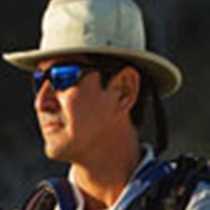Genovesa Island is home to over one million seabirds. Our highlights today were diverse, leaving us delighted to see Nazca, red- and blue-footed boobies, gulls, owls, fur seals, hammerheads sharks, turtles, and manta rays
Our adventure began with a wet landing on a white coralline beach inside Darwin Bay, named by celebrity visitor William Beebe in honor of a great naturalist who re-shaped human thought on evolution, Charles Darwin. At low tide and over a platform we walked surrounded by birds of all kinds, observing their chicks, their different behaviors, and their various colors. We were moved by these active seabirds, especially as we observed parents taking care of juveniles, in hopes that one day they can fend for themselves. We were also happy to spot a few marine iguanas, which are smaller and darker than others we’ve seen, as this northern hemisphere island has a different ecology than nearby ones and thus, different wildlife results.
When we reached our turning point, we were surprised to see an interesting bird behavior: a red-footed booby adopting a frigate bird chick (without the parent’s permission!). The chick’s mother was eagerly trying to take the booby out the nest (without significant result) until we left.
Back aboard we prepared for our last snorkeling outing in search the undersea realm. Today we had close encounters with many fish and playful sea lions for the last time. Seeing them up close brought excitement and admiration. And yet some of us opted to spend time beach snorkeling instead, which ended up a challenge as the season are changing faster than expected!
After this great adventure we came back to our ship, anchored inside the Genovesa caldera, to be briefed about our departure to enjoy our last delicious lunch, the pride of our culinary staff.
After lunch we opted for a last kayak outing, and then began our next adventure—a visit to Prince Philip’s Steps. Nazca and red-footed boobies surrounded us, and we spotted frigate birds and even the elusive short-eared owl. We felt rewarded to have this unique view of a camouflaged diurnal raptor. Taking this walk was like traveling back in time. Birds flew overhead like in prehistoric eras, and the surrounding lava formations resembled the first foundation of Earth.
Later we returned to the ship and reminisced about our many experiences this week. As we gaze on the islands one last time, the Galapagos feels timeliness. It’s now deep within our hearts, these special islands where wildlife has no fear and allow us to see their lives are not so different than our own. We must not acknowledge the methodical saying “don’t humanize the animals,” but instead “animalize the human” by perceiving our surroundings with all our senses; embracing nature by coexistence and respect for one another, so we can become one with nature as we once were.
Here in Galapagos we have all bonded like a family, united by this invisible mysticism. At the end of our journey we hope to stay in touch and that the experiences shared by our guests will stay with them for a lifetime.









